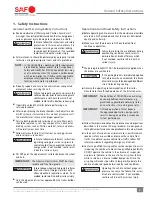
17
XL-AS20012BM-en-US Rev B · 2014-05-28 · Amendments and Errors Reserved · © SAF-HOLLAND, Inc., SAF-HOLLAND, HOLLAND,
SAF, and logos are trademarks of SAF-HOLLAND S.A., SAF-HOLLAND GmbH, and SAF-HOLLAND, Inc.
Maintenance and Service Schedule
14. Routine Maintenance and
Daily Inspection
1. Daily or before each trip, check the suspension to be sure
it is fully operational.
2. Inspect all decals to ensure they are clearly legible and
intact. Clean with a terry cloth towel, soap and water.
3. Visually inspect air springs for sufficient inflation and
that the suspension is at proper ride height. For ride
height details and measurements, refer to Section 8
of this manual.
4. Inspect the slider lock pins and slider pull handle for
signs of excessive wear, bending or binding.
5. Inspect the front and rear hold down clips to ensure that
they are correctly secured around the body rails.
14.1 Initial Three (3) Months or 5,000 Mile
(8,000 km) Service Inspection
1. Suspension ride height (underside of frame to centerline
of axle) MUST be within ±1/4" (6 mm) of recommended
design height. For instructions on measuring ride height,
refer to Section 8.
An improperly set ride height could result
in suspension component damage and/or
poor vehicle ride performance.
2. After first three (3) months or 5,000 miles (8,000 km)
of service, whichever comes first, inspect bolts and nuts
at the pivot connections to ensure they are properly
torqued. Check all other nuts and bolts for proper torque,
refer to the specifications listed in Section 15. Re-torque
as necessary thereafter.
3. With the vehicle on a level surface and air pressure above
85 psig (5.9 bars), verify that all air springs are of sufficient
and equal firmness.
NOTE:
Check all air control system fittings for air leaks,
by applying a soapy water solution and checking
for bubbles at all air connections and fittings.
14.2 Routine Physical Inspections
Every 100,000 Miles (160,000 km) or one (1) year, whichever
comes first.
Check all other suspension components for any sign of damage,
looseness, torque loss, wear or cracks. Repair, tighten or
replace damaged part(s) to prevent equipment breakdown.
14.3 Visual Inspection Procedure
IMPORTANT:
A schedule for physical and visual inspections
should be established by the operator
based on severity of operation or damage
to the vehicle could occur.
IMPORTANT:
During each pretrip and safety inspection
of the vehicle, a visual inspection of the
suspension should be done or damage to
the vehicle could occur.
Visually check for:
Loose, broken or missing fasteners. Repair or replace
as needed.
Loose, damaged, or missing fasteners
can cause loss of vehicle control which,
if not avoided, could result in death or
serious injury.
Air springs – clearances, wear damage, and proper inflation.
Shock absorbers – leaking or damaged.
Cracked parts or welds.
Also:
Check the slider locking pins, slider pull-bar mechanism
and slider wear pads for signs of excessive wear or
binding, refer to Section 11
(Figure 18)
. Repair or
replace as needed.
Inspect the structure of the slider box and cross members
for damage, refer to Section 11
(Figure 18)
. Repair or
replace as needed.
Inspect the front and rear hold down clips to make
certain the clips are secured correctly around the body
rails, refer to Section 11
(Figure 18)
. Torque all 1/2"
OVUTUPGUMCT /tN




































